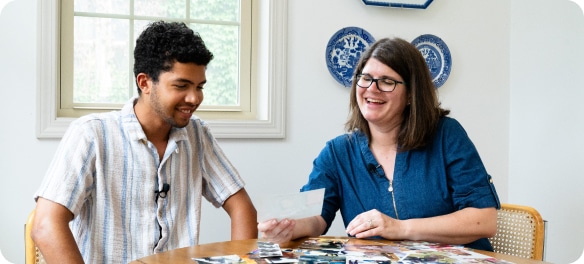Anna’s story: Navigating life with her son’s brain tumor diagnosis
When Bradon was diagnosed with a brain tumor at 11 years old, “it felt like the answer to years of subtle concerns”, said his mother, Anna. As a child, his development always lagged slightly behind what seemed normal, but doctors reassured them that everything was fine. One weekend, the signs became too glaring to ignore. He kept falling and tripping, and when his school gave him an elevator pass because he was unstable climbing the stairs, Anna knew it was time to see a doctor.
Bradon couldn’t walk on his tiptoes or heels properly, and the questions from the medical team became more unsettling. A few days after an MRI, they got the diagnosis: Bradon had a brain tumor. A pediatric low-grade glioma (pLGG), at the base of his brainstem and extending into his cervical spine, was the culprit. “It was devastating, but in a way, it explained everything – his clumsiness, delayed development, even the subtle slope of his shoulder. All the little signs we had dismissed now made sense,” Anna recalls.

The weight of the news was overwhelming and the numbness she felt didn’t fade quickly. Anna remembers, “I couldn’t cry at home or in front of my kids,” she recalled. “I’d pull over in a Walmart parking lot, let it all out, and then pull myself together for the day.”
Confronting misconceptions, treatment hurdles, & finding strength in community
At first, Anna thought that the next steps would be straightforward: surgery to remove the tumor, and then life would go back to normal. She even considered attending a work trip soon after the procedure. But the reality hit hard: the journey wasn’t just surgery—it was radiation, chemotherapy, and the lingering side effects and uncertainty that would stretch across years. A turning point in the journey was finding an online support group. For Anna, the group became a lifeline. It gave her a place to share Bradon’s story, ask questions, and connect with other parents who had been down the same road. “It saved my sanity,” Anna said. “Their insights, whether confirming a symptom or urging me to call a doctor – were invaluable.”
One of the most frustrating parts of Bradon’s diagnosis was the misunderstanding surrounding pediatric low-grade gliomas. “People would say, ‘At least it’s not cancer,’ as if it wasn’t dangerous,” Anna recalled. “But it is cancer. Just because it grows slowly doesn’t make it any less threatening—it’s still inside his brain, affecting critical areas like the brainstem.” She was frustrated by how easily others dismissed it as “just a low-grade glioma,” not recognizing the emotional and medical challenges that come with it. “All childhood tumors are terrifying; they all change a child’s life in profound ways.”
Letting go but never fully
Even now, years later, the fear hasn’t entirely left, and Anna still finds herself struggling to let go as Bradon is learning to navigate adulthood with pLGG on his own. Whenever Bradon returns home and she sees him struggle to tie his shoes or stumbles, she immediately jumps in. “It’s hard not to fall back into that hyper-protective mode, but I know this separation is necessary for both of us”.
Even after two years of stability and improvement for Bradon, each annual scan brings the same questions for Anna: Is it stable? Has anything changed? Are we good for another year? The waiting never gets easier.
“In the beginning, the frequent scans were comforting. Someone was always watching closely. But as the intervals stretched to six months, then nine, and now a year, it became harder to adjust. Eventually, he’ll go to the appointments on his own, and I’ll just get a phone call.” She smiled, imagining him saying, “It’s fine, Mom.” But she knows she’ll have a dozen follow-up questions he won’t think to ask.